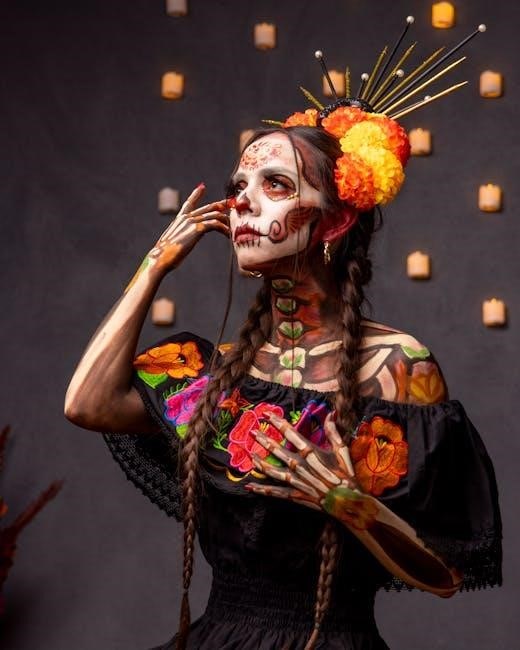Andrés Caicedo’s Que Viva la Música! is a gripping novel about a young girl’s obsession with music, set against the vibrant nightlife of Cali, Colombia.
1.1 Overview of the Novel and Its Author, Andrés Caicedo
Andrés Caicedo was a Colombian writer born in 1951, known for his intense and passionate literary style. His novel Que Viva la Música!, written between 1972 and 1974, is his only completed novel. It follows a young girl obsessed with music, immersing herself in Cali’s vibrant nightlife. The narrative, told through a first-person perspective, reflects Caicedo’s unique style, blending raw emotion with deep societal insights. This work is celebrated for its unflinching portrayal of youth and rebellion, resonating deeply with readers.
1.2 Historical Context of the Novel’s Publication
Que Viva la Música! was published in 1977, a time of significant cultural and social change in Colombia. Written between 1972 and 1974, the novel captures the essence of the 1970s, reflecting the vibrant yet turbulent atmosphere of the era. Set against the backdrop of Cali’s dynamic nightlife, the story resonates with the youth of that period, exploring themes of rebellion and identity. Caicedo’s work anticipated future societal shifts, making it a timeless reflection of Colombian culture and youth struggles during that pivotal decade.
Plot Summary of “Que Viva la Música!”
The novel follows a young girl consumed by her passion for music, immersing herself in Cali’s vibrant nightlife, where music becomes her ultimate escape and obsession.
2.1 The Protagonist’s Obsession with Music
The protagonist’s obsession with music drives the narrative, as she immerses herself in Cali’s vibrant nightlife, finding solace and identity through her passion for sound and rhythm.
Her relentless pursuit of music becomes an escape from reality, shaping her interactions and decisions, while reflecting the societal tensions and cultural shifts of 1970s Colombia.

2.2 The Setting: Cali’s Nocturnal Life
The novel is set against the backdrop of Cali’s dynamic nightlife, where music and vibrant cultural scenes dominate the city’s after-dark atmosphere.
This setting becomes a character in itself, shaping the protagonist’s experiences and obsessions, while reflecting the broader social and cultural shifts of 1970s Colombia.
2.3 The Narrative Style and Its Impact on the Reader
The novel employs a first-person narrative, creating an intimate and immersive experience; The protagonist’s voice is raw and introspective, drawing readers into her emotional turmoil and obsession. Caicedo’s unique writing style, marked by vivid descriptions and a fragmented structure, mirrors the chaos of the protagonist’s mind. This narrative approach forces readers to engage actively, interpreting the blurred lines between reality and fantasy. The intense, almost desperate tone leaves a lasting impression, making the story unforgettable and deeply personal. The style amplifies the novel’s emotional and psychological depth, resonating with readers on a profound level.
Cultural and Social Themes in the Novel
The novel reflects 1970s Colombian society, exploring themes of youth rebellion, music as escapism, and societal pressures. It also delves into queer and decolonial perspectives, offering a critique of cultural norms and colonial heritage, while highlighting the transformative power of music and individual resistance in a oppressive environment, making it a powerful commentary on identity and freedom.
3.1 The Reflection of Colombian Society in the 1970s
Que Viva la Música! captures the vibrant yet turbulent essence of 1970s Colombia, particularly in Cali, where the protagonist’s obsession with music mirrors societal upheaval. The novel portrays a generation grappling with inequality, cultural shifts, and the lingering effects of colonialism. Through the protagonist’s immersion in nocturnal life and music, Caicedo critiques the rigid norms of Colombian society, offering a raw portrayal of youth rebellion and the struggle for identity in a transforming world.
3.2 The Role of Music as a Form of Escape
Music serves as a powerful escape for the protagonist in Que Viva la Música!, offering solace from the oppressive realities of her world. Through her immersion in Cali’s nightlife and the vibrant sounds of salsa and tropical rhythms, she finds temporary liberation. Music becomes her sanctuary, a space where she can transcend societal constraints and express her true self. This theme underscores the universal human need for artistic expression as a means of coping with adversity and finding personal freedom.
3.3 The Representation of Youth and Rebellion
The novel vividly portrays youth as a symbol of rebellion against societal norms. The protagonist embodies this spirit, rejecting traditional expectations through her relentless pursuit of music and nightlife. Her defiance reflects the broader struggles of young individuals in 1970s Colombia, seeking identity and autonomy. Caicedo’s depiction captures the raw energy and angst of adolescence, presenting youth as a force challenging societal structures and embracing freedom, even in the face of adversity and cultural constraints.

Literary Analysis of “Que Viva la Música!”
The novel explores themes of youth rebellion and cultural resistance through its unique narrative style, blending music and Colombian identity to create a vivid, immersive experience.
4.1 The Use of First-Person Narrative
The novel employs a first-person narrative, immersing readers in the protagonist’s intense emotional journey. This perspective amplifies the personal and obsessive relationship with music, creating a direct connection with the reader. By presenting actions through the narrator, Caicedo invites reflection and interpretation, enhancing the story’s depth. The intimate tone allows exploration of internal conflicts and desires, making the narrative both vivid and thought-provoking. This storytelling approach underscores the protagonist’s identity and her rebellion against societal norms, central to the novel’s themes.
4.2 Symbolism and Metaphors in the Text
Music serves as a powerful symbol of escape and rebellion in Que Viva la Música!. The protagonist’s obsession with music metaphorically represents her desire to break free from societal constraints. The nightlife of Cali is depicted as a symbolic space of freedom and self-expression. Caicedo uses vivid imagery and metaphors to convey the protagonist’s internal struggles and her quest for identity. These elements enrich the narrative, offering layers of meaning that resonate deeply with themes of youth rebellion and cultural resistance.
4.3 The Author’s Unique Writing Style
Andrés Caicedo’s writing in Que Viva la Música! is characterized by its intense, immersive narrative style. The use of a first-person female narrator creates a direct, intimate connection with the reader. Caicedo’s prose is raw and passionate, reflecting the protagonist’s obsessive relationship with music and nightlife. His unique voice blends urgency with poetic descriptions, capturing the chaotic yet liberating essence of youth and rebellion. This distinct style has made the novel a standout in Colombian literature, resonating with readers for its authenticity and emotional depth.
Queer and Decolonial Perspectives
The novel explores queer and decolonial perspectives through its narrative, reflecting themes of subversion and cultural resistance in Colombian society through Andrés Caicedo’s unique lens.
5.1 Sexual Subversion in the Novel
The novel explores themes of sexual subversion through its queer narrative, challenging traditional norms in 1970s Colombia. Caicedo’s protagonist embodies this subversion, navigating a world of repressed desires and societal expectations. The text subtly critiques heteronormativity, offering a decolonial perspective on sexuality. Through its bold portrayal, the novel becomes a manifesto of sexual liberation, reflecting the author’s intent to subvert colonial legacies and embrace identity fluidity. This aspect remains central to its queer and decolonial reinterpretation, resonating deeply with contemporary readers.
5.2 Cultural Resistance and Decolonial Themes

Que Viva la Música! embodies cultural resistance through its portrayal of Cali’s vibrant nightlife as a space of defiance against societal norms. The novel challenges colonial legacies by celebrating local music and identity, offering a decolonial perspective on Colombian culture. Caicedo’s narrative subverts traditional structures, blending indigenous and urban influences to create a unique cultural tapestry. This decolonial approach not only critiques colonialism but also empowers marginalized voices, making the novel a powerful statement of cultural resistance and identity reclamation.

Reception and Impact of the Novel
Que Viva la Música! received acclaim for its raw portrayal of Colombian society and its anticipation of cultural phenomena. It remains a significant influence on contemporary literature.
6.1 Initial Reception and Critical Reviews
The novel Que Viva la Música! received critical acclaim upon its release, praised for its intense narrative and raw portrayal of Colombian society. Critics highlighted its ability to anticipate societal phenomena, making it a significant work in Colombian literature. The novel’s unique first-person narrative and its exploration of music as a form of escape resonated deeply with readers. Its publication in 1977 marked a turning point, solidifying Caicedo’s reputation as a bold and innovative writer. The book’s impact continues to be felt in contemporary literary circles.
6.2 The Novel’s Influence on Contemporary Literature

Andrés Caicedo’s Que Viva la Música! has significantly influenced contemporary Colombian and Latin American literature. Its bold narrative style and exploration of youth rebellion and social issues have inspired many writers. The novel’s unique first-person perspective and raw portrayal of societal challenges continue to resonate, making it a reference point for modern authors. Its themes of cultural resistance and decolonial thought have also sparked new movements in literary creation, ensuring its lasting impact on the literary landscape. The novel remains a vital source of inspiration today.

Availability of “Que Viva la Música!” in PDF Format
The novel is available in PDF format on platforms like Lectulandia and Internet Archive. Ensure downloads are from legal sources to respect copyright laws.
7.1 Sources for Downloading the PDF
Que Viva la Música! can be found in PDF format on various platforms like Lectulandia and Internet Archive. These sites offer free access to the novel, allowing readers to explore Andrés Caicedo’s vivid portrayal of a young girl’s obsession with music amidst Cali’s nightlife. Always verify the legality of the source to ensure compliance with copyright laws and support authors and publishers.

7.2 Legal and Ethical Considerations
Downloading Que Viva la Música! in PDF format requires respecting copyright laws. Ensure sources are legal to avoid piracy. Purchasing the book supports the author and publishers. Always verify the legitimacy of download platforms to ethically access the novel. ResearchGate and authorized sellers are reliable options for legal access. Respect intellectual property to promote fair practices in literature.
Que Viva la Música! by Andrés Caicedo is a profound exploration of music, rebellion, and Colombian culture; Its intense narrative and relatable themes resonate deeply with readers. The novel’s availability in PDF format, through legal sources like Amazon and ResearchGate, ensures accessibility while respecting copyright. This masterpiece continues to inspire, offering a vivid portrayal of youth and societal challenges, cementing its legacy in contemporary literature.
